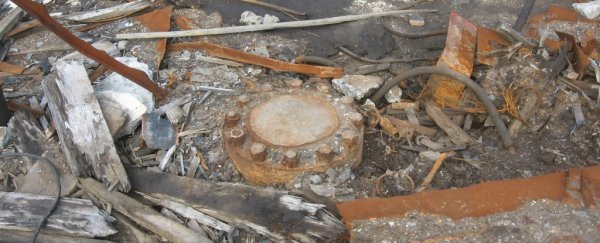Lying below a small, nondescript rusty cap in Murmansk, Russia, is the deepest hole ever drilled, reaching a whopping 12 kilometres (7.5 miles) into the Earth's crust.
Known as the Kola Superdeep Borehole, the human-made hole seems like it should be leftover from a failed oil well, but it's actually the result of over 20 years of Cold War fighting between the US and USSR who were locked in a technological arms race to see who could potentially drill into the centre of the Earth.
Yup, the two mightiest superpowers of the time – both capable of destroying the human race in a single afternoon – were competing to see who could dig the deepest hole like two bored kids in a backyard.
The funny thing is that the drilling largely went unnoticed because the world was fixated on the space race that resulted in landing on the Moon.
The story of the Kola Superdeep Borehole started back in the early-1960s as the space race was heating up.
Researchers in both Russia and the US separately began drilling into the Earth's crust for no other reason than to see how far they could get, a feat that proved far more difficult than either team could have imagined.
In the US, the drilling happened under the name of 'Project Mohole', which took place off of Mexico's Pacific coast. The team managed to drill 183 m (601 feet) below the sea floor, in 3,600 m (11,700 feet) of water.
Despite successfully proving that offshore drilling was possible – a feat that, according to Atlas Obscura, set a precedent for today's offshore oil drilling – the project was defunded in 1966, though the reason why isn't really mentioned.
Meanwhile, in Russia, scientists started drilling into the Kola Peninsula – a region that lies at the northern tip of the country – after hearing about America's attempt.
Unlike the US project, though, the USSR was able to keep drilling from around 1970 until 1994, creating the Kola Superdeep Borehole, the deepest hole ever created by humans.
But there are very few technical details about what the crews had to do to make the hole a reality.
The coolest thing is that even though the hole might have started out of Cold War aggression, the researchers working with the drilling team were able to make a plethora of scientific studies about the Earth's crust seeing as they were able to physically study it, a task that is still extremely hard today.
"By far the most riveting discovery from the project, however, was the detection of microscopic plankton fossils in rocks over 2 billion years old, found four miles beneath the surface," reports Bryan Nelson from Mother Nature Network.
"These 'microfossils' represented about 24 ancient species, and were encased in organic compounds which somehow survived the extreme pressures and temperatures that exist so far beneath the Earth."
Despite this success, the drilling came to a halt in 1994 because temperatures in the surrounding earth skyrocketed from around 100 degrees Celsius (212 degrees Fahrenheit) to 180 degrees Celsius (356 degrees Fahrenheit), causing the drill to malfunction.
The project was officially terminated in 2005, leaving only a rusted metal cap as a marker of its existence.
Check out the video below to find out more about the Kola Superdeep Borehole:

